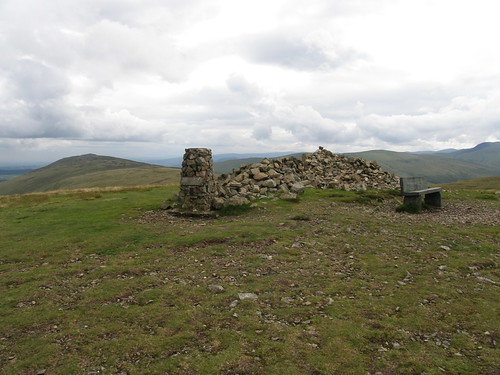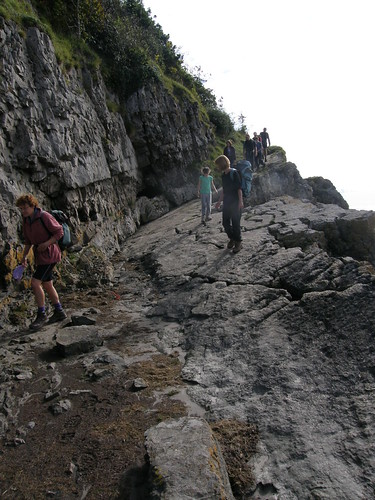
The approach to the foot of the mountain resembled the approaches to the feet of most other mountains. The cultivation gradually ceased, the trees grew gradually rare, the road became gradually rougher, and the sides of the mountain looked gradually more and more lofty, and more and more difficult to get up.
from The Lazy Tour of Two Idle Apprentices
That’s from 1857, but it’s still a pretty fair description of my drive to the foot of Carrock Fell. When I climbed out of the car I was surprised by the cold slap of the wind. My ascent would take a rising line under the right-hand corner of those broken crags and then into and up a grassy gulley to the skyline, where the gradient eases. But first, I paused a while to watch a buzzard’s slow trawl along the top edge of the crag and then a a kestrel poised above a lone tree silhouetted against the sky.
One way and another, my scramble to bag the Birketts has stumbled this year. First my damaged ankle kept me off the hills and since then I’ve climbed hills on the edge of the Pennines, in the Forest of Bowland and in North Wales, but the only times I’ve been out in the Lakes I either haven’t climbed any hills or I’ve re-ascended tops which I’ve already ticked off. So for this away-day I’d chosen something to give the whole thing a bit of a kick-start: unfamiliar territory with nine relatively easy ‘summits’ to be bagged.
Of course, nothing’s ever easy: although my parking spot near Stone Ends Farm gave me a pleasingly high start, the first part of the climb was fairly steep. In the event, despite the need for windscreen-wipers on my eyes as perspiration gushed down my forehead, I found a nice steady rhythm and enjoyed the challenge.
At the top edge of the crags, I paused again as three ravens repeatedly sailed past, gurgling their lovely catarrhal croaks. I didn’t get much further up the path before my progress was halted again: a grouse stood proud on the hillside just ahead. I expected that it would whirr noisily away, but instead it just ducked down behind some heather so that only it’s head was showing…

I waited with my camera, hoping that it would show itself more fully. A kestrel swooped by; maybe it was the kestrel I had seen from below. If it was a kestrel: it was surprisingly pale, but the right sort of size and shape.
Eventually, my patience paid off: the grouse trundled across the heather onto a prominent perch on a rock and then a second popped-up from a hiding place…

…and then a third…

…and a fourth. The three ravens made a reappearance and all five grouse launched themselves onto the wind. Even when they took off, they were eerily quiet, none loosed that abrupt rattling ‘here I am, shoot me’ call. I wondered whether they were a family group. None had the red wattle which distinguishes the male.
Up and up and up again, till a ridge is reached and the outer edge of the mist on the summit of Carrock is darkly and drizzingly near. Is this the top? No, nothing like the top. It is an aggravating peculiarity of all mountains, that, although they have only one top when they are seen (as they ought always to be seen) from below, they turn out to have a perfect eruption of false tops whenever the traveller is sufficiently ill-advised to go out of his way for the purpose of ascending them. Carrock is but a trumpery little mountain of fifteen hundred feet, and it presumes to have false tops, and even precipices, as if it were Mont Blanc. No matter; Goodchild enjoys it, and will go on: and Idle, who is afraid of being left behind by himself, must follow.
from The Lazy Tour of Two Idle Apprentices
In fact, Carrock Fell is not a serious offender in this regard, at least not from the direction from which I climbed it, and I was soon on the top. What’s more, unlike the maniacally energetic Goodchild and the indolent Thomas Idle, I had a view, even if it was “like a feeble water-colour drawing half sponged out”. Goodchild and Idle are the alter-egos of the close friends Charles Dickens and Wilkie Collins. They took a tour of Cumberland together and then satirised themselves in Dickens’ Household Words.
I must confess that I’d never heard of their tour, or their report of it, until I bought this book…

…from the Oxfam bookshop in Lancaster this week. It’s from 1954 and looks like marvellous stuff, starting with early travellers like William Camden, Daniel Defoe and Celia Fiennes, taking in the writers of Tour Guides like Pennant and West, the Romantic Poets (Wordsworth fits both of the last two categories), and finishing with more recent Lakeland luminaries like Ruskin, Beatrix Potter, Cannon Rawnsley, W.G.Collingwood, Walpole and W. Heaton Cooper, who also provides illustrations and the jacket painting.
Only now, as I flick through it again, have I discovered a neat, typed name and address label, dated “Aug ‘75”, which shows that a previous owner of the book lived in a house just across the road from home.
Anyway, back to my walk: Dickens makes no mention of the remains of an iron-age hill-fort on the summit of Carrock Fell. After the grandeur of Tre’r Ceiri earlier this summer, I found it distinctly underwhelming by comparison.

My next target would be High Pike, seen here on the right…

…although there were a couple of minor bumps on the soggy ridge inbetween which I would slalom to incorporate, because of their Birkett status.
At first I mistook this huge fly, mesembrina meridiana, for a substantial bumble bee, purely because of its size.

Diverting to Round Knott at least took me wide of the most egregious bog.

Looking back to Carrock Fell.

Round Knott Cairn. Blencathra and Skiddaw behind.

High Pike
So far I’d had the hills to myself. On the boggy ridge I saw a walker with a collie heading the other way, but we didn’t meet since I’d left the main path to take in Round Knott. Now as I approached the final climb to High Pike I met another single walker, with two collies. Neither were on leads. Both were very friendly. One much too friendly. After it had put its paws on my chest, sniffed my privates and nestled it’s snout in my bum, I pushed it away with a trekking pole, on which I then skewered it’s owner, explaining, as he breathed his last, that not everyone likes dogs and that if he’d been a little more considerate he could have avoided being kebabed.
No I didn’t. I smiled weakly and said something innocuous like, “Nice day for it.”
“I thought I’d got the hills all to myself,” with a grin.
A fellow misanthrope; I warmed to him. Maybe I won’t garrotte him on this occasion.
He strode away, unaware of his narrow escape.

Carrock Fell again.
The next walker I met also had a collie, or perhaps I should say that the next collie I met also had a walker in tow? I began to worry that I’d stumbled into some strange convention for lone walkers with collies, like something from Sherlock Holmes, but the next walkers I met were a couple with a boxer and something like a lurcher.

High pike has a fair accumulation of summit furniture: a trig pillar, an untidy, sprawling cairn and a stone bench. Squadrons of wasps flying in formation low to the turf were everywhere. They didn’t bother me whilst I ate some lunch, and I wondered what they were doing in such an apparently unpromising spot if they weren’t there to mug walkers and steal their sandwiches.
High Pike, and the Caldbeck Fells in general, are renowned for their mineral wealth and geological interest. I didn’t spot much, but I did pass a bright, white rock with an intricate crystalline structure embedded in the path…

Three more minor bumps to negotiate on route to Knott: Hare Stones, Great Lingy Hill and Little Lingy Hill. All three have cairns optimistically plonked close to where it’s almost possible to imagine that there might be a highest point. They give pleasant, rough, almost pathless walking.

Wainwright says of Great Lingy Hill: “Acres of dense fragrant heather make this the most delectable top in Lakeland for a summer day’s siesta.” I thought it seemed a bit wet for that, but when the sun almost shone on Little Lingy Hill, I did spread my cag on the sward, stretch out and shut my eyes for a while.

The crossing from Little Lingy Hill was wetter and rougher then anything I had yet encountered. That didn’t seem to perturb this….

…common lizard, which squirmed through the grass and disappeared before I could get a better picture.
Despite the fact that when I’d last seen them they’d been heading in the opposite direction, the misanthrope and his dogs had some how made it to the top of Knott before me. Maybe they’d made the unfortunate decision not to have a wee snooze. They strode away when they saw me coming to mar their splendid isolation.
The air had cleared a little and the hills across the Solway Firth had become more than the vague hint of landscape which they’d been up to that point. From my grandstand seat I watched showers tracking across the plains which flank the estuary.


Skiddaw seen above Great and Little Calva.

Threatening clouds.

High Pike and Carrock Fell from Knott.
Another boggy ridge took me Coomb Height, the final Birkett of the day. I descended by Grainsgill Beck and then followed the unfenced road by the River Caldew to Mosedale, where I was surprised to find a cafe operating in the local Friends Meeting House.

The cakes looked nice and the tea was hot and wet and reasonably priced.

Next door, in the barn attached to the Meeting House, was an Aladdin’s cave come charity shop.

In the meeting house was a display of rubbings of dates and initials taken from local houses and associated with the Quaker community. This area is one of the birthplaces of Quakerism; George Fox is another of the early writers anthologised in Prose of Lakeland. Walking through Mosedale I noticed a couple of houses with initials and eighteenth century dates. This one…

…a large double fronted house with an air of shabby gentility and an unkempt garden looked particularly romantic and worthy of exploration.
















































































































































